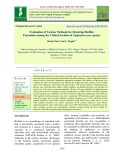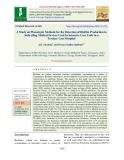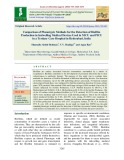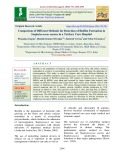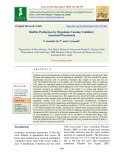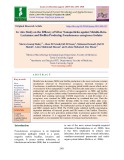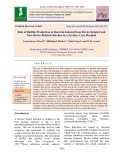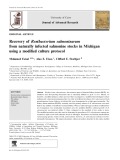
Tissue culture plate
-
In light of the same, the objectives of this study include to isolate various Staphylococcus species from clinical specimens. And also to compare three phenotypic methods for detection of biofilm formation among the isolated Staphylococcus species, namely, Tube adherence method, Tissue culture plate method and Congo red agar method.
 9p
9p  nguaconbaynhay7
nguaconbaynhay7
 15-08-2020
15-08-2020
 13
13
 1
1
 Download
Download
-
Biofilms are surface associated bacterial communities surrounded by a matrix of exopolymers. Biofilms contribute to the development of persistent infections due to their refractiveness to antibiotic therapy. The purpose of this study was to evaluate three methods for detection of biofilm formation in different indwelling devices.
 13p
13p  angicungduoc5
angicungduoc5
 14-06-2020
14-06-2020
 12
12
 0
0
 Download
Download
-
Biofilms are surface associated bacterial communities surrounded by a matrix of exopolymers. Biofilms contribute to the development of persistent infections due to their refractiveness to antibiotic therapy. The purpose of this study was to evaluate three methods for detection of biofilm formation in different indwelling devices.
 9p
9p  kethamoi5
kethamoi5
 03-06-2020
03-06-2020
 24
24
 1
1
 Download
Download
-
Biofilm is the population of bacterial cells growing on the biotic and abiotic surfaces embedded in a matrix of extracellular polysaccharide, which facilitate the adherence of microorganism. This study is aimed to compare and evaluate different Methods for detection of Biofilm formation in Staphylococcus aureus isolates. For comparison of different methods of Biofilm production, 100 isolates of Staphylococcus aureus (50 MRSA and 50 MSSA) were taken and screened by tissue culture plate method, tube method in different condition and Congo Red Agar (CRA) plate method...
 8p
8p  angicungduoc4
angicungduoc4
 04-05-2020
04-05-2020
 25
25
 0
0
 Download
Download
-
Biofilm formation by Staphylococcus aureus and Staphylococcus epidermidis is a common cause of chronic infection and intravascular device failure. Biofilms are resistant to almost all available drugs rendering them difficult to treat. Thus, there is a need to identify natural compounds which can inhibit biofilm formation. A total of 52 multi drug resistant isolates of Staphylococcus aureus and Staphylococcus epidermidis were isolated from various clinical samples. Isolates were identified by standard microbiological procedures.
 6p
6p  kethamoi4
kethamoi4
 16-04-2020
16-04-2020
 9
9
 0
0
 Download
Download
-
Ventilator-associated pneumonia is defined as nosocomial pneumonia occurring more than 48 hours after patients have received mechanical ventilation. VAP in a critically ill patient significantly increases risk of mortality, ventilator time, length of stay and cost of care. The Endotracheal tube is a favourable site for biofilm formation. They are adherent cells which are embedded within a self-produced matrix of This EPS matrix impedes the normal functions of antibodies and the phagocytic cells of the immune system and leads to increased resistance to antibiotics.
 8p
8p  cothumenhmong4
cothumenhmong4
 25-03-2020
25-03-2020
 8
8
 0
0
 Download
Download
-
Metallo beta-lactamase (MBL) and biofilm production is the most worrisome resistant mechanisms observed in Pseudomonas aeruginosa. Increased resistance of Pseudomonas to antibiotic therapy is an emerging global health concern which can be overcomed by Silver nanoparticles (AgNPs). Therefore this study aims to evaluate the antibacterial and antibiofilm activity of Silver nanoparticles on MBL and biofilm producing P. aeruginosa isolates using Transmission Electron microscope (TEM) and Confocal laser scanning microscope (CLSM) respectively. A total 40 isolates of p.
 18p
18p  chauchaungayxua3
chauchaungayxua3
 07-02-2020
07-02-2020
 11
11
 0
0
 Download
Download
-
The use of indwelling devices both temporary and permanent, in medical and surgical practice has led to the emergence of implant associated infections in the patients admitted in a Tertiary care hospital leading to partial or complete therapeutic failure. The study was conducted to detect and compare biofilm production in bacteria isolated from device related (DR) and non-device related (NDR) infections by Tissue Culture Method (TCP).
 9p
9p  nguaconbaynhay1
nguaconbaynhay1
 04-12-2019
04-12-2019
 17
17
 0
0
 Download
Download
-
Renibacterium salmoninarum, the causative agent of bacterial kidney disease (BKD), is a fastidious and slow-growing bacterium that is extremely difficult to grow in vitro. Herein, we describe a modified primary culture protocol that encompasses a modified bacteriological culture medium and a tissue processing procedure. In order to facilitate the release of R. salmoninarum from granulomatous tissues, kidneys of infected fish were homogenized in a high speed stomacher. The kidney disease medium (KDM2), routinely used for primary culture of R.
 8p
8p  kethamoi1
kethamoi1
 20-11-2019
20-11-2019
 11
11
 1
1
 Download
Download
-
There are several other reasons why sponges are a model laboratory organism to explore the biological consequences of environmental pollution. For the purposes of ease of set-up, freshwater sponges represent a cost- and time-effective study organism. Gemmules grow relatively quickly (within 3-5 days) and require very little equipment to grow. All of our sponges were grown in 24- well tissue culture plates.
 5p
5p  tainhacmienphi
tainhacmienphi
 19-02-2013
19-02-2013
 59
59
 2
2
 Download
Download
CHỦ ĐỀ BẠN MUỐN TÌM








